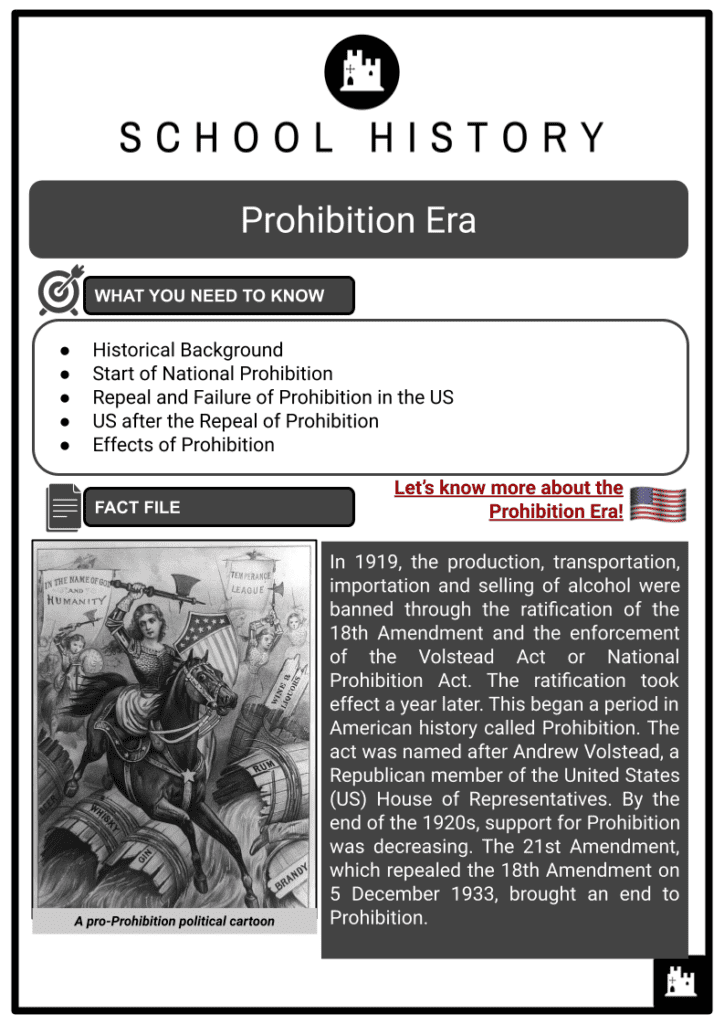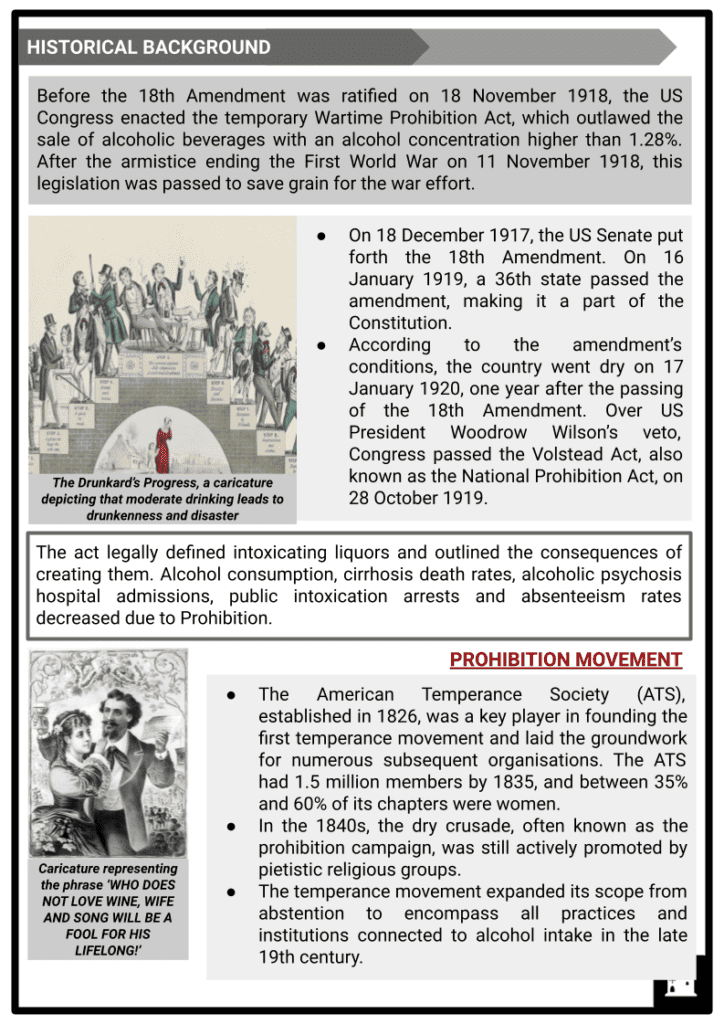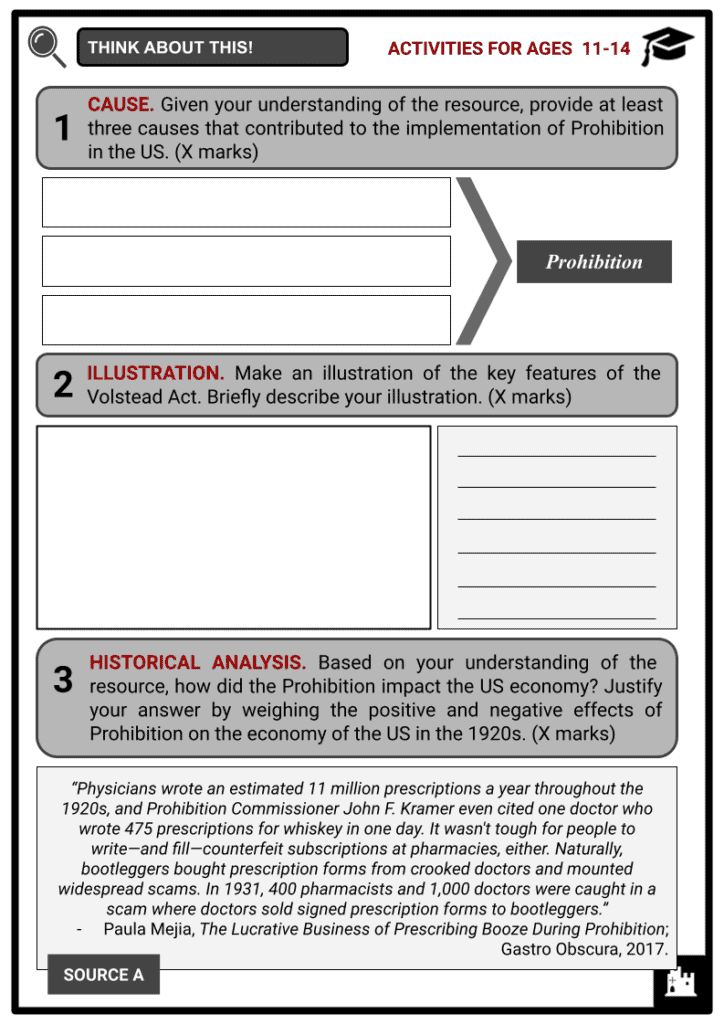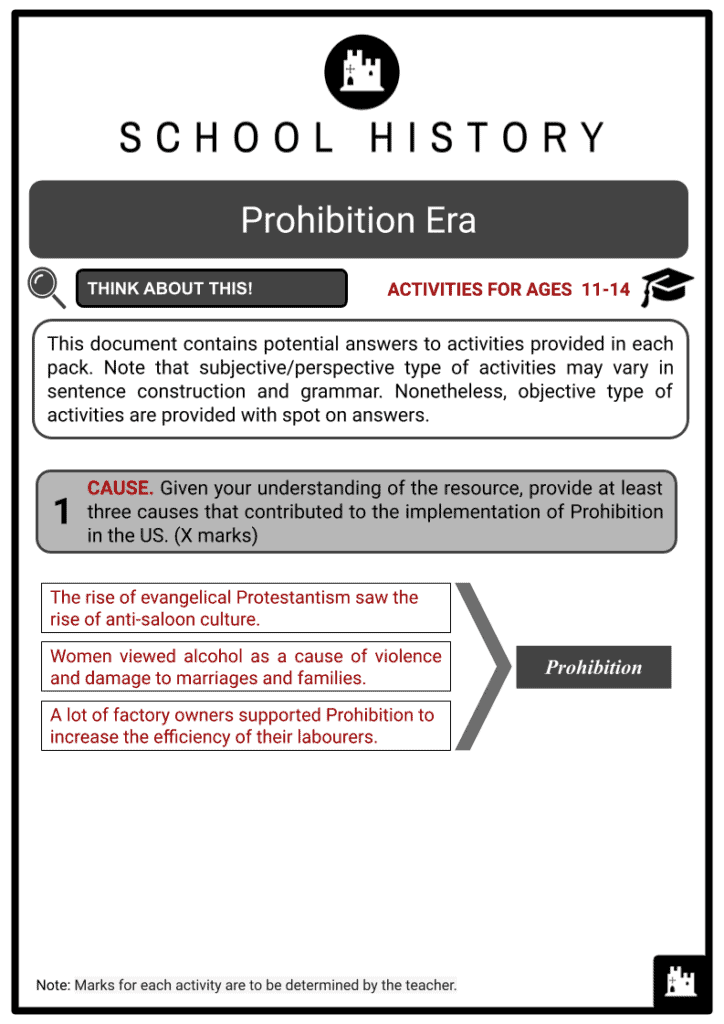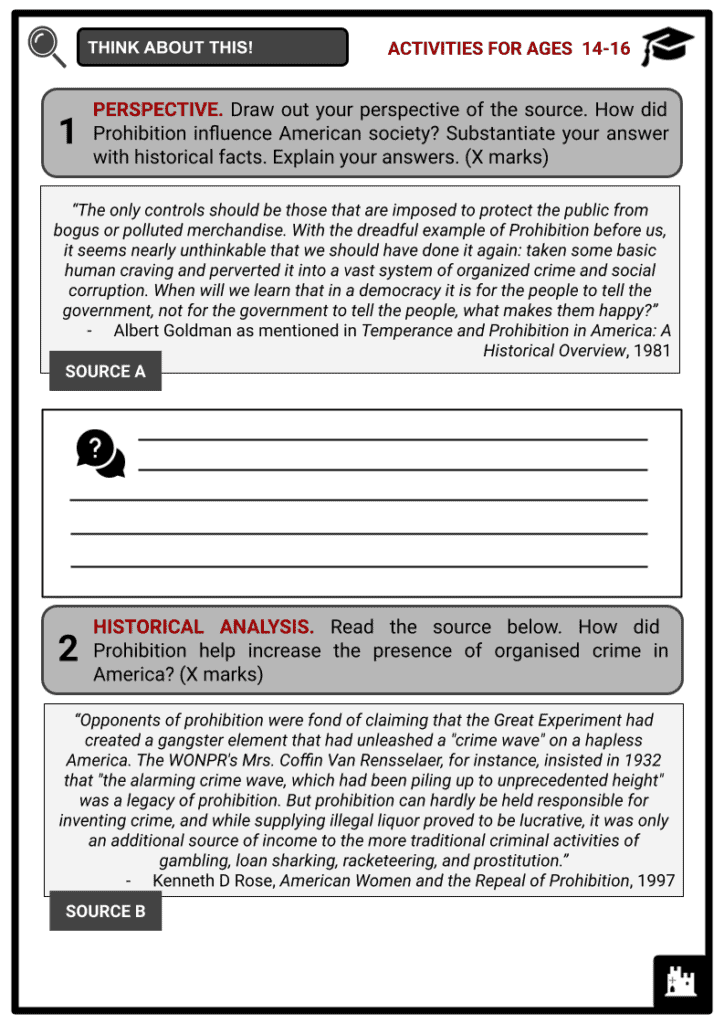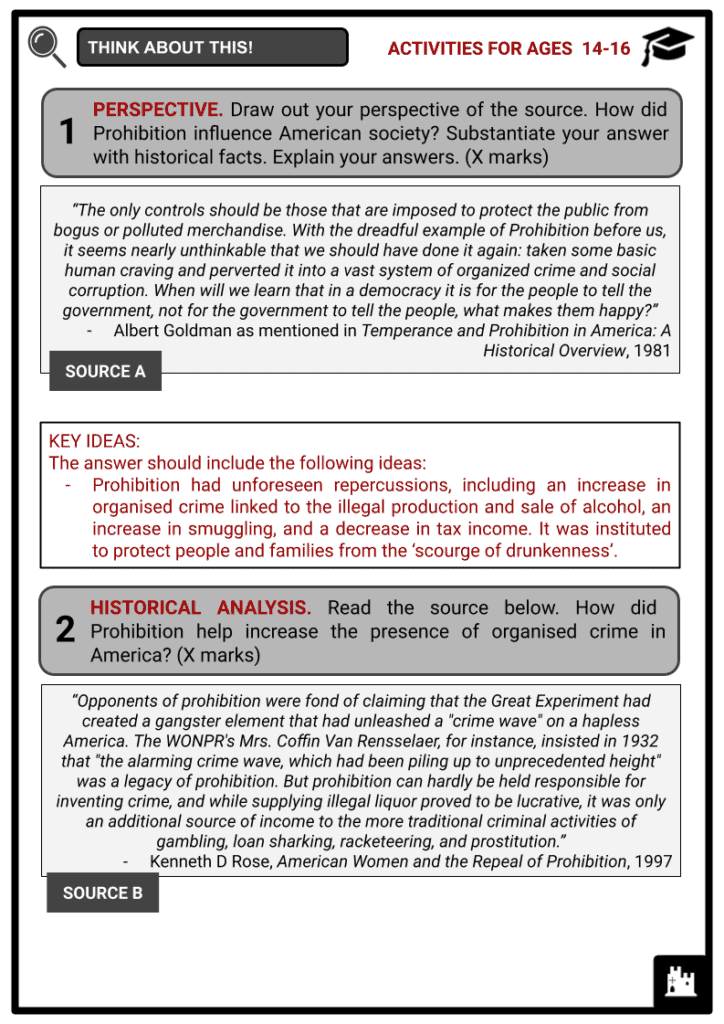Prohibition Era Worksheets
Do you want to save dozens of hours in time? Get your evenings and weekends back? Be able to teach about the Prohibition Era to your students?
Our worksheet bundle includes a fact file and printable worksheets and student activities. Perfect for both the classroom and homeschooling!
Summary
- Historical Background
- Start of National Prohibition
- Repeal and Failure of Prohibition in the US
- US after the Repeal of Prohibition
- Effects of Prohibition
Key Facts And Information
Let’s know more about the Prohibition Era!
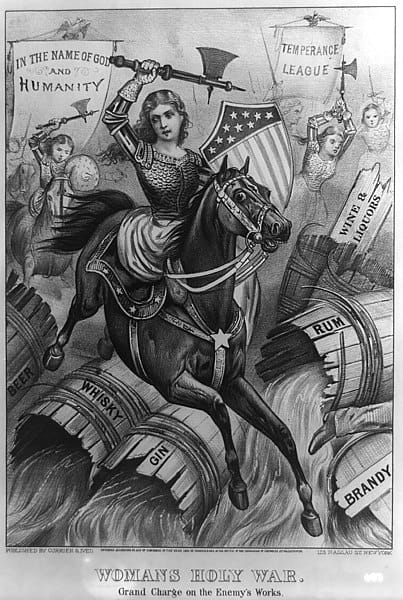
In 1919, the production, transportation, importation and selling of alcohol were banned through the ratification of the 18th Amendment and the enforcement of the Volstead Act or National Prohibition Act. The ratification took effect a year later. This began a period in American history called Prohibition. The act was named after Andrew Volstead, a Republican member of the United States (US) House of Representatives. By the end of the 1920s, support for Prohibition was decreasing. The 21st Amendment, which repealed the 18th Amendment on 5 December 1933, brought an end to Prohibition.
HISTORICAL BACKGROUND
- Before the 18th Amendment was ratified on 18 November 1918, the US Congress enacted the temporary Wartime Prohibition Act, which outlawed the sale of alcoholic beverages with an alcohol concentration higher than 1.28%. After the armistice ending the First World War on 11 November 1918, this legislation was passed to save grain for the war effort.
- On 18 December 1917, the US Senate put forth the 18th Amendment. On 16 January 1919, a 36th state passed the amendment, making it a part of the Constitution.
- According to the amendment’s conditions, the country went dry on 17 January 1920, one year after the passing of the 18th Amendment. Over US President Woodrow Wilson’s veto, Congress passed the Volstead Act, also known as the National Prohibition Act, on 28 October 1919.
- The act legally defined intoxicating liquors and outlined the consequences of creating them. Alcohol consumption, cirrhosis death rates, alcoholic psychosis hospital admissions, public intoxication arrests and absenteeism rates decreased due to Prohibition.
PROHIBITION MOVEMENT
- The American Temperance Society (ATS), established in 1826, was a key player in founding the first temperance movement and laid the groundwork for numerous subsequent organisations. The ATS had 1.5 million members by 1835, and between 35% and 60% of its chapters were women.
- In the 1840s, the dry crusade, often known as the prohibition campaign, was still actively promoted by pietistic religious groups.
- The temperance movement expanded its scope from abstention to encompass all practices and institutions connected to alcohol intake in the late 19th century.
- The Maine statute passed in 1851, which outlawed the production and sale of alcohol, was one of the movement’s victories in the 1850s. Before it was repealed in 1856, 12 states had total prohibition policies similar to Maine’s.
- Social moralists shifted their focus after the war to other topics, including Mormon polygamy and the temperance movement.
- The National Prohibition Party, established in 1869, and the Woman’s Christian Temperance Union (WCTU), established in 1874, revitalised the Prohibition movement.
- The WCTU promoted alcohol prohibition to prevent abuse from alcoholic husbands through education. Members of the WCTU believed that if their group could get its message over to kids, it could spark a dry feeling that would lead to Prohibition.
- From the 1840s until the 1930s, Prohibition exerted significant political influence at the state and local levels. Numerous historical investigations have established the ethno-religious nature of the political dynamics.
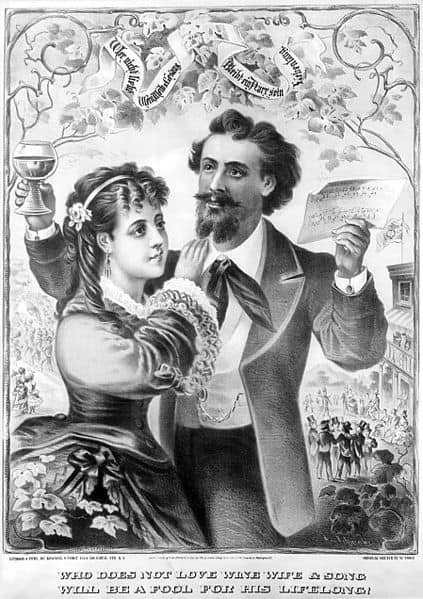
Caricature representing the phrase ‘WHO DOES NOT LOVE WINE, WIFE AND SONG WILL BE A FOOL FOR HIS LIFELONG!’ - Prohibition symbolised a developing tension between rural and urban ideals in the United States. Many members of the Prohibition movement believed that American cities’ high immigrant populations were to blame for the high crime rates and morally corrupt behaviour.
START OF NATIONAL PROHIBITION
- The Volstead Act entered into effect on 17 January 1920, marking the start of Prohibition. The responsibility of enforcement fell to 1,520 Federal Prohibition police. The amendment’s supporters quickly gained confidence that it would not be repealed. Since doctors frequently recommended alcohol throughout the era for therapeutic purposes, Prohibition became quite contentious among medical experts. In 1921, Congress convened hearings on the therapeutic potential of beer.
- Physicians nationwide subsequently fought for Prohibition’s inclusion of therapeutic liquors to be repealed. Doctors wrote almost $40 million of whisky prescriptions between 1921 and 1930. While it was unlawful to produce, import, sell or transport alcohol in the US, Section 29 of the Volstead Act permitted the production of wine and cider.
- As alcohol was allowed in the surrounding nations, distilleries and breweries grew in Canada, Mexico and the Caribbean as their goods were either drunk by tourists from the United States or illegally smuggled into the country.
- The Detroit River, a portion of the border between the United States and Canada, was famously difficult to manage, mainly because of rum-running in Windsor, Canada.
- The head of the British Colonial Office declined to step in when the American government complained to the British that authorities in Nassau, Bahamas, were undermining American law.
- Many members of the higher classes stocked up on alcohol before the 18th Amendment took effect in January 1920 so that it would be lawful to consume it at home after Prohibition started.
- They emptied the warehouses, saloons and club storerooms of liquor sellers and wholesalers by purchasing their inventories.
- Bootlegging grew in popularity once the 18th Amendment was made a legal requirement. During the first half of 1920, 7,291 cases of violations of the Volstead Act were opened by the federal government.
- Even though grape juice that had been left to sit for 60 days, during which it would ferment and transform into wine with a 12.5% alcohol concentration, it was not prohibited under Prohibition. As the production of grape juice increased fourfold during the Prohibition Era, many people profited from this. Vine-Glo, a grape concentrate brick product, was marketed specifically for this use and came with a warning label describing how to produce wine from it.
- The federal government mandated the denaturation of industrial alcohols, which meant they had to have chemicals to make them toxic or unappealing to stop bootleggers from using them to make illegal beverages.
- In response, bootleggers engaged chemists who could make them drinkable by removing the additives.
- The Treasury Department demanded that producers add more lethal poisons in response, including the highly lethal mixture known as methyl alcohol: 4 parts methanol, 2.25 parts pyridine base, and 0.5 parts benzene per 100 parts ethyl alcohol.
- Charles Norris, a medical examiner in New York City, thought the government was guilty of murder after continuing to poison industrial alcohol while knowing the poison did not stop consumption.
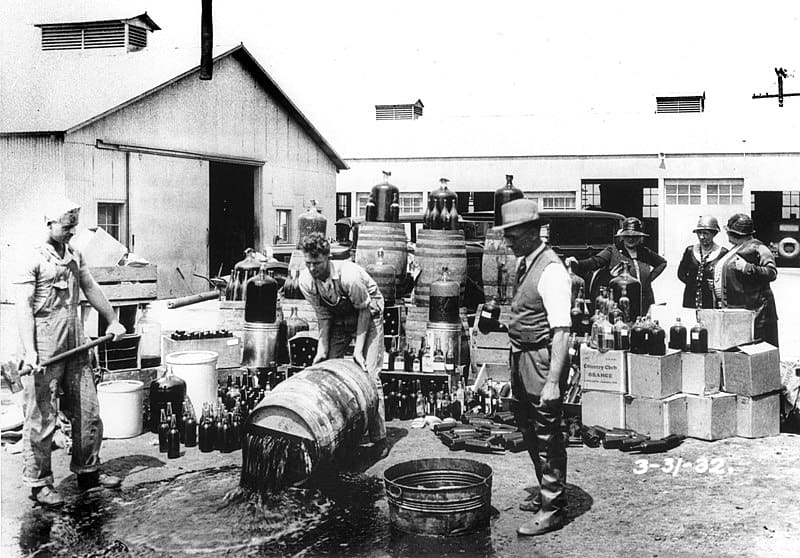
Orange County, California, sheriff’s deputies dumping illegal alcohol “The government knows it is not stopping drinking by putting poison in alcohol ... [Y]et it continues its poisoning processes, heedless of the fact that people determined to drink are daily absorbing that poison. Knowing this to be true, the United States government must be charged with the moral responsibility for the deaths that poisoned liquor causes, although it cannot be held legally responsible.” - Charles Norris
- In northern cities, home-distilled hard liquor was known as bathtub gin. In contrast, it was known as moonshine in rural Kentucky, Virginia, South Carolina, North Carolina, Georgia, West Virginia and Tennessee. It was simpler to make decent hard liquor at home than good beer.
- Police officers chased producers tenaciously because selling distilled alcohol privately was prohibited, and they avoided paying taxes.
- Many suppliers and bootleggers with sympathies towards producing and drinking alcohol transitioned into the legal alcohol industry once Prohibition was lifted in 1933.
- Some organised criminal groups shifted their focus to growing their protection networks to include legitimate alcohol sales and other business sectors.
Agencies tasked to enforce the Volstead Act
- US Coast Guard Office of Law Enforcement
- US Treasury’s IRS Bureau of Prohibition
- US Department of Justice Bureau of Prohibition
REPEAL & FAILURE OF PROHIBITION IN THE US
- Naval Captain William H Stayton founded the Association Against the Prohibition Amendment (AAPA) in 1918 and was a key figure in the anti-Prohibition movement. The AAPA was the biggest of the almost 40 groups that pushed to repeal Prohibition.
- Fewer conservatives first supported Prohibition. Because of the detrimental consequences that Prohibition had on the agriculture industry, many farmers had previously pushed for its repeal.
- On 5 December 1933, the 21st Amendment to the US Constitution was ratified, resulting in the 18th Amendment’s repeal.
- The 21 Utah representatives to the constitutional convention unanimously ratified the 21st Amendment on that day, making Utah the 36th state to do so and ensuring that the repeal of the 18th Amendment passed with the necessary number of votes despite the efforts of the President of the Church of Jesus Christ of Latter-day Saints, Heber J Grant.
Failure:
- Those who wanted to keep consuming alcohol developed tactics to get around the legislation.
- This led to a rise in the rates of organised crime.
- People relied on bootlegging, the unlawful manufacture and sale of alcohol. Even if there was a decline in arrests related to drunkenness, the rate of criminal activity related to bootlegging and smuggling rose.
- Speakeasies were created. Speakeasies are bars hidden away from the public eye.
- The smuggling of alcohol from one state to another occurred.
- Moonshine was produced in-house.
US AFTER THE REPEAL OF PROHIBITION
- The 21st Amendment allows for local and state control of alcohol but does not prevent states from restricting or outright banning it. Instead, it prohibits the importation or carriage of alcohol into any US state, territory or possession in contravention of local legal restrictions.
- In the US, several dry counties and towns still regulate or forbid the sale of alcohol. A dry county is one whose government outlawed the sale of alcoholic beverages in the US. Additionally, alcohol is not allowed on many native reserves. Following its abolition, some former supporters candidly acknowledged failure.
- Following the abolition of federal Prohibition, 18 states kept it at the state level. Shortly after the Second World War, a nationwide opinion poll revealed that about one-third of Americans favoured national Prohibition.
- In 1966, Mississippi, the last state, ended it. Nearly two-thirds of all states adopted a local option, which allowed citizens in political subdivisions to vote for or against local Prohibition. Therefore, even after Prohibition was abolished nationwide, 38% of Americans resided in regions where it was still in effect on a state or municipal level.
EFFECTS OF PROHIBITION
HEALTH
- According to an article by Mark H Moore in The New York Times published in 1989, liver cirrhosis rates considerably decreased during Prohibition and then rose following its repeal. Liver cirrhosis is a condition in which the liver is scarred and permanently damaged.
CRIME
- It has been argued that Prohibition gave organised crime a significant boost. For instance, one study discovered that organised crime in Chicago tripled during Prohibition. Alcohol had a thriving black market that was often violent and lucrative. Organised crime was able to thrive because of Prohibition.
ECONOMY
- Washington State University claims that Prohibition had a detrimental effect on the US economy. Supporters of the ban anticipated a rise in the sales of non-alcoholic beverages to make up for the lost tax revenue from the sale of alcohol, but this did not materialise, resulting in a loss of at least $226 million annually.
Frequently Asked Questions
-
What was the Prohibition Era?
The Prohibition Era refers to the period in U.S. history from 1920 to 1933 when the 18th Amendment to the United States Constitution prohibited the production, sale, and distribution of alcoholic beverages.
-
Why was the Prohibition Era implemented?
The Prohibition Era was implemented in response to a widespread temperance movement that aimed to reduce the negative social effects of alcohol.
-
Who ended the Prohibition Era?
The Prohibition Era was officially ended by ratifying the 21st Amendment to the United States Constitution. Upon taking office, President Franklin Roosevelt called for the legalisation of beer and wine to end Prohibition, and he signed the Amendment into law shortly after its ratification.

